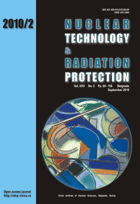
SIMULATION OF THE TOTAL EFFICIENCY OF CYLINDRICAL SCINTILLATION GAMMA-RAY DETECTORS FOR DISK SOURCES

Vol.
XXV, No. 2, Pp. 69-156
September 2010
UDC 621.039+614.876:504.06
ISSN 1451-3994
Pages: 85-92
Authors: Shakeel U. Rehman, Sikander M. Mirza, and Nasir M. Mirza
AbstractThe total efficiency of cylindrical scintillation g -ray detectors has been determined using a novel, primary interaction based Monte Carlo algorithm. With the use of biasing in these simulations, this approach has been made computationally efficient, yielding converged results with standard errors less than a fraction of a percent for about 104 histories which is about two orders of magnitude smaller than the conventional stochastic techniques. This methodology has been implemented in a MATLAB based computer program, DSEMC. For thin disk sources of various radii having coaxial configurations, the predictions of the DSEMC code have been found in excellent agreement with the corresponding results obtained by using the direct analytical technique. Similar agreement has also been found in the DSEMC calculated values of total efficiency and the corresponding results obtained by the direct analytical technique for coaxial thin disk sources of various radii over a wide range of g -energies.
The DSEMC program has been used for the determination of total detection efficiency for off-axial configurations. As the disk source radius increases, results show a gradual decreasing trend in total efficiency. For these configurations, energy dependency of the total efficiency is found to follow the variation of the corresponding total attenuation coefficient which is consistent with the expected behavior. For coaxial thin disk sources, the total detection efficiency has been found to approach a corresponding maximum value as length is increased in the 1-20 cm range for various values of radii of disk sources and g -ray energy, while keeping the diameter of the detector fixed at 7.62 cm. A similar behavior is observed when the radius of the detector is increased from 1-20 cm, while keeping the length of the detector fixed at 7.62 cm for various values of radii of disk sources and g -ray energy.
Key words: gamma-ray detector, total efficiency, disk source, Monte Carlo simulation
FULL PAPER IN PDF FORMAT (934 KB)
Last updated on September, 2010